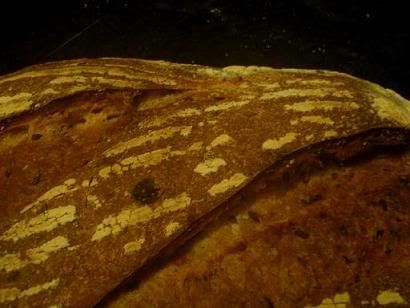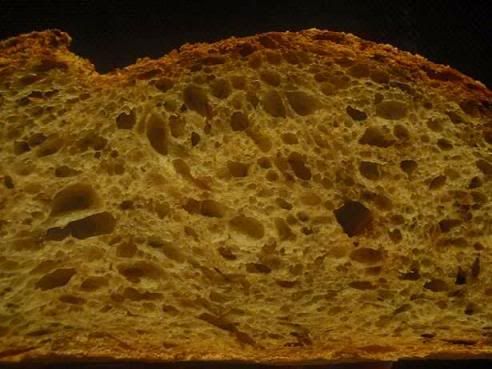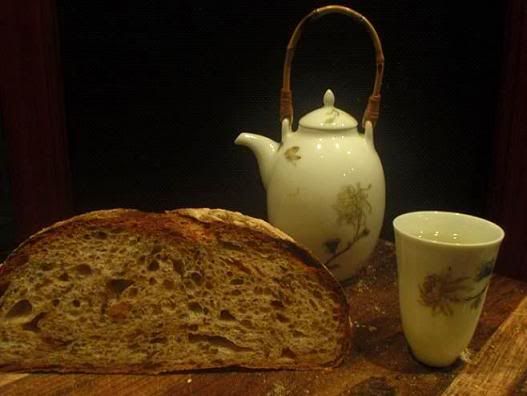Yes, made with sesame oil, shallots and shallot onions.
I ask for indulgence to call this Chinese Sourdough. Sesame oil to Chinese is like olive oil to Italians; it can work wonders if you know how. For instance, when you made Rustic Walnut Bread, if you drop a couple of teaspoonfuls of sesame oil to the dough you are mixing, you will get a more intense nutty flavor. It has a delightfully surprising effect on the aroma of your bread. Sesame oil is like a strong version of walnut oil, very compatible, both being extremely good for you.
When I was growing up as a kid, we always had sesame oil in the house: a few drops in the noodles with soy sauce; a few drops in the stock pot for stews; a few drops in the soy sauce and vinegar mixture as a dipping sauce for dumplings (Chinese "dumpling" are like the Italian ravioli's); and so on. In the traditional markets that we used to go to, the fruit and vege owners would always give us a bunch of shallots for free. As far as I know, Chinese cook [color=red]everything[/color] with a little bit of shallots and garlic.
I was over-joyed the other day when I found a jar of sesame oil-fried shallots and shallot onions in the Taiwanese grocery store in Brisbane. The small shallot onions, about an inch in diameter or even smaller, are often deep-fried in Southeast Asia to add to any dishes for extra flavor. I had just gotten my starter out of the fridge last night (I needed to make my daily bread today) when I saw the jar sitting in the pantry.... Hmmmm.... sesame oil-fried shallots.... and daily bread? YES, why not?
So, here is my formula:
250 g sourdough starter @75% hydration prepared last night, as well as
50 g linseed (ie, flax seeds) soaked in 60 g water
For the dough this morning:
All of the above and
40 g organic stoneground wholemeal flour
40 g rye meal flour
20 g Phyto Soy L.S.A. mix (linseed, sunflower, & almonds)
500 g organic unbleashed white flour
400 g water
80 g sesame oil-fried shallots & shallots onions (with the oil drained off)
10 g organic honey
13 g Celtic sea salt
a small pinch of Vitamin C
And here are the bread and the rolls:

[color=red]Chinese Sourdough with Sesame Oil & Shallots[/color]

[color=red]close-up of the crust[/color]

[color=red]The Crumb[/color]
I will be very happy serving this bread at my dinner party. The aroma when it came out of the oven is something I've never had before. The flavor is beautifully enrished by the sesame oil shallots mixture. The small amounts of wholemeal, rye and L.S.A mix all add to the complexity. There is an overall harmoney to my taste.
A nice day ended.

Shiao-Ping
- Shiao-Ping's Blog
- Log in or register to post comments
Oh wow!!! Those breads look absolutely wonderful!
Thank you for sharing this great idea, Shiao-Ping. I usually make bread with pretty much the same ingredients, but I have not tried adding sesame oil (I use it a lot in cooking, and love the taste of it).
This will be my next bread adventure for sure.
Using sesame oil, shallots, and shallot onions seems like very unusual ingredients for a sourdough since the the sesame oil has such a strong flavor. Does the bread still have a sourdough taste? So you drained off the oil and just used the solids (I'm trying to visualize how much 80 g is--I imagine about a tablespoon?). I'm not sure what the distinction is between shallots and shallot onions. In the US we have shallots, smallish golden little bulbs containing two 'halves' and scallions, long slender, pencil-like young onions that are green on the top and white at the very bottom. but that doesn't sound like what you mean by shallot onions. As for the wholemeal flour, is that hard winter or spring whole wheat, or soft red wheat?
In any event, your bread looks very delicious. I make a pan bread of flour, sesame oil, sesame seeds, green onions, and salt, but it doesn't contain yeast. Still I think its flavor is delicious.
--Pamela
Thank you for waking me up! I also use sesame oil quite often, but had not considered using it in bread. Soon, I will. Your breads are beautiful.
Susan from San Diego
What a great idea! And I've gotta try that too! I have everything here in my Korean apartment just waiting. I think I may try it as a pizza dough first. Thanks!
Lovely pictures and tea pots! The pumpkin shaped one makes the sd loaf & rolls look huge!
Mini
It never occurred to me to use sesame oil in bread even though I love that ingredient. Like you I put it on pasta, on greens but in bread, I just never thought of it. I will try! Your big loaf looks lovely but I would settle for one of the rolls if you could email it to me! I'll have to try and find a Taiwanese market to get hold of some of the ingredients you are using. What fun! I love discovering new frontiers in taste!
Like others, I love sesame oil and use it in Chinese dishes. It would never have occurred to me to use it in bread. I bet it would be delicious in a bread that also had sesame seeds on the crust. Have to try it!
David
No oil. Hey everyone it looks like she didn't use the oil; only the goodies.
--Pamela
Shiao-Ping,
A very nice sounding combination indeed. You there in Brisbane giving us a lesson in creativity. Don't stop I am so loving your work.
A question on the Phyto Soy L.S.A. mix (linseed, sunflower, & almonds). When I search on that I get capsules of powder. Are you using some other ingredient. Perhaps you could describe it or add an image.
Thank you,
Eric
Hi Pamela,
I raced to my local supermarket to get these photos:
[color=brown]shallot onions or onion shallots[/color]
The one you described is called salad onions in Australia; it may (and I am certain of that) have a different name in other countries. This is however not what is used in the sesame oil-fried shallots combo. It is the brown one from the third picture above that is used. I didn't explain fully yesterday but you can get deep-fried "onions" in a jar in Asian store quite easily - these "onions" are however not our normal onions, they are shallot onions! (As I said yesterday these shallot onions are used in Southeast Asian countries quite a lot to add on to any dishes to get extra flavor.) Note also they [color=red]rarely[/color] use sesame oil (it's normally just any vegetable oil). Sesame oil is more a Mainland Chinese oil. The warm temp in Southeast Asian countries has meant traditionally they have not required such a cooking oil, which has a warming property (ie, rich Vitamin E, etc.)
The jar that I used for my Chinese Sourdough is quite an unusual thing in that it uses sesame oil and, in addition to shallot onions, it has shallots. Like olive oil where you have virgin, extra virgin or light variety, sesame oil is the same. Because of its low burning temp (which is unlike olive oil as the latter can withstand relatively high heat before it becomes smoky) it is the extra light version that is used to shallow-fry shallots. If you want to do it yourself at home, max a 1/4 of the quantity of oils you are using in sesame oil is enough (the balance in other type of oil, eg. vegetable oil).
The reason that I drained off the oil from the jar was simply because I had already had enough liquid for my dough. It would be perfectly OK to use it if you adjust it for your hydration.
The wholemeal flour that I used is high gluten (15%) hard red spring wheat flour.
You are right to query the sourdough taste, given the strong sesame flavor. This morning when I phoned my mum in Taiwan to tell her about it, her first reaction was, "Sesame oil?" She used to make a swirl shallots pancake in winter when we were little, and she used just normal cooking oil. My answer to your question is that the sourdough taste came through the mouth feel as well as the crumb, being so moist, but yeah, you are right, this is not a traditional sourdough and to go light-handed in sesame oil would be a good idea.
In fact, this is not the healthiest Chinese Sourdough one can think of. I'll be doing a fresh shallots version soon.
Thank you for your comment.
Hi Shiao-Ping.
Thanks for posting the pictures! What you call "shallots" we, in the US, call scallions (AKA green onions). Your "salad onions" are called "spring onions" here. Lastly, we call your "scallions" shallots. It's amazing that it is almost totally backwards for us.
One point of clarification: from reading your ingredients, it appears that you aren't actually using the oil but only 80 g of the mixture left off after draining the oil. Am I understanding that correctly?
--Pamela
Hi Eric
Here is a picture of L.S.A mix that I used:
It is more for fun than anything else as the amount I put in was so little. Together with the linseeds (you call flax seeds in America), wholemeal wheat flour, and rye meal flour, this sourdough is loaded with stuff! These ingredients are really there just for fun.
Thank you very much for your comment.
Shiao-Ping
Thank you Shiao-Ping for clarifying that. From the looks of the half full bag you must be having a lot of "fun" with it. Now I know what to look for when I visit the Asian Market in Milwaukee.
I very much enjoy the deep flavor of the flax seed after they have been soaked overnight. Do you sometimes add walnuts to this bread with the seseme oil?
I love making savory aromatic breads and I'm dying to try this.
Eric
Shaio-Ping, that looks really great. I will give it a try.
How long do you soak flaks? I always find it a bit chewey, so I will try that in the future.
Great pictures as well. PS in Holland we call shallots 'spring onions'
Cheers,
Jw.
That's very lovely, Shiao-Ping! We have a bottle of sesame oil but I never knew what to do with it. It must be over 10 years old. Do you think I still can use it?
By the way, what's the difference between green onions and shallots? Last year, my husband bought me some green onions and shallot bulbs for planting. They did look different but when they came out from the ground, I couldn't tell which one was which.
Xaipete Pamela,
Yes, the shallots/onions (AFTER the oil was roughly drained off) was 80g; you can't absolutely drain every bit of oil off, some still stuck in the creases of deep-fried shallots/onions.
Just to let you know I made pizzas using sesame oil, I was going to use a teaspoon, like Susan of San Diego, into my dough but ended up (oops!) using a good tablespoon in 500g of dough. Handling the dough, my hands smelled strongly of sesame oil but as it turned out my worry was unnecessary. Upon eating the pizza, neither I nor my husband could taste or smell the sesame oil. My green onions (maybe they were Chinese chives) went on top with the rest of the toppings. It sure was a good pizza! I'd do it again!
Susan couldn't taste it either in her walnut bread but she says she can smell it. Says if she didn't know it was there, she wouldn't single it out. Her husband flunked the taste test, couldn't single it out but agreed it is very tasty sourdough bread.
Mini
Hi althetrainer,
Please see [url=http://www.thefreshloaf.com/node/12491/chinese-sourdough-bread#comment-72196/][color=red]xaipete's comments[/color][/url] for different names of the same stuff in the US and also [url=http://www.thefreshloaf.com/node/12491/chinese-sourdough-bread#comment-72164/][color=green]the pictures here for clarification[/url][/color]. In Holland, the name is different yet again, see [url=http://www.thefreshloaf.com/node/12491/chinese-sourdough-bread#comment-72248/][color=blue]Jw's comment here[/color][/url].
Wikipedia has the following [url=http://en.wikipedia.org/wiki/Scallion][color=purple]information[/color][/url]:
"A scallion, also commonly known as spring onion, green onion, or salad onion, is associated with various members of the genus Allium that lack a fully-developed bulb. Harvested for their taste, they tend to be milder than other onions.... "Scallion" is sometimes used for Allium ascalonicum, better known as the shallot."
If your sesame oil is 10 years old, I would not use it. In fact, anything more than 2 years may be a problem depending on its origin and how good its quality to start with.
Shiao-Ping
Yes, I have read both but only got more confused because the terms are used differently in different countries. I guess I didn't ask my question clearly so let me rephase it... when it comes to using green onion and shallots, do you use them specifically or interchangeably? Do they taste differently and yield significant results if you replace it with one another?
I will chuck the sesame oil out. When I decide to try some in my bread making I may buy another one. Thanks!
If I add just a few drops of sesame oil in a stir fry you can smell and taste it. Perhaps it is the high temperature in the wok that releases the flavor? Or the dough encapsulates the oil hiding it from your taste buds.
When you added it to your pizza dough, did you saute any onions using this oil?
Many of the savory spices I use with oil don't show up at the party unless they are infused in warm oil overnight. Maybe the same is true here and a retarded ferment would help bring out the flavor. Just thinking out loud.
Eric
No, Eric, interesting point. If sesame oil is heated to high temperatures before going into the dough, it might make a difference, maybe more or maybe less. I don't know. I almost always saute the onions to "glassy" but these were frozen and would go mushy if I fried them first. So the onions went straight onto the sauce, over the meat but under the cheese.
My point is that the raw oil (Susan's was also raw) when baked into bread is not so dominant as one might think. I would imagine that heat was also used to toast the seeds before pressing. I have the medium, toasted seed oil, not a light one. The lighter ones known for having the lighter flavors.
Mini
Hi Eric
I made walnut raisin bread with sesame oil very often. It is a very good combination as sesame oil really brings out the flavor of walnuts (funny that !)
Hi Mini
The "pumpkin" shaped teapot is only 4.5cm in height, so it does make the bread look huge. The shape in Mandarin is called "chrysanthemum flower."
Hi althetrainer,
Sorry I didn't understand you; sometimes I don't read properly. I am assuming the one you call "green onion" is the one on my picture called "salad onion" (or "spring onion" according to Pamela). To me, green onion is like a baby version of the normal onions; I think the taste of the bulb is similar to normal onion, except that it has a stalky portion that is like shallots. For Chinese in general, it is either shallots or normal onions (I don't remember my mother ever used green onions). When used fresh (I mean, raw) in salad, green onions is less "spicy" as normal onions and I like it better. But for cooking, I like shallots better (Chinese do in general). I would say, in terms of taste and smell, shallots is a lot stronger than green onion. Hope this answer your question. The rest is really individual preference.
Thank you for your query.
I've been cooking for almost 40 years and have always associated the following by these names.
Scallions AKA Green Onions
Shallots
Spring Onions
--Pamela
Hi, Woz,
What is Chinese Garlic Chives? Do you mean the long skinny green looking thing? I think in Queensland, they call it just "chives." Yes, I am sure it will work too.
Don't you love the web? Imagine trying to sort out these scallions/shallots business over the telephone! I live in the US, so I share Pamela's terminology but it is very useful to have your pictures, Shiao-Ping, so that we understand which ones you actually used at each step. Thank you both!